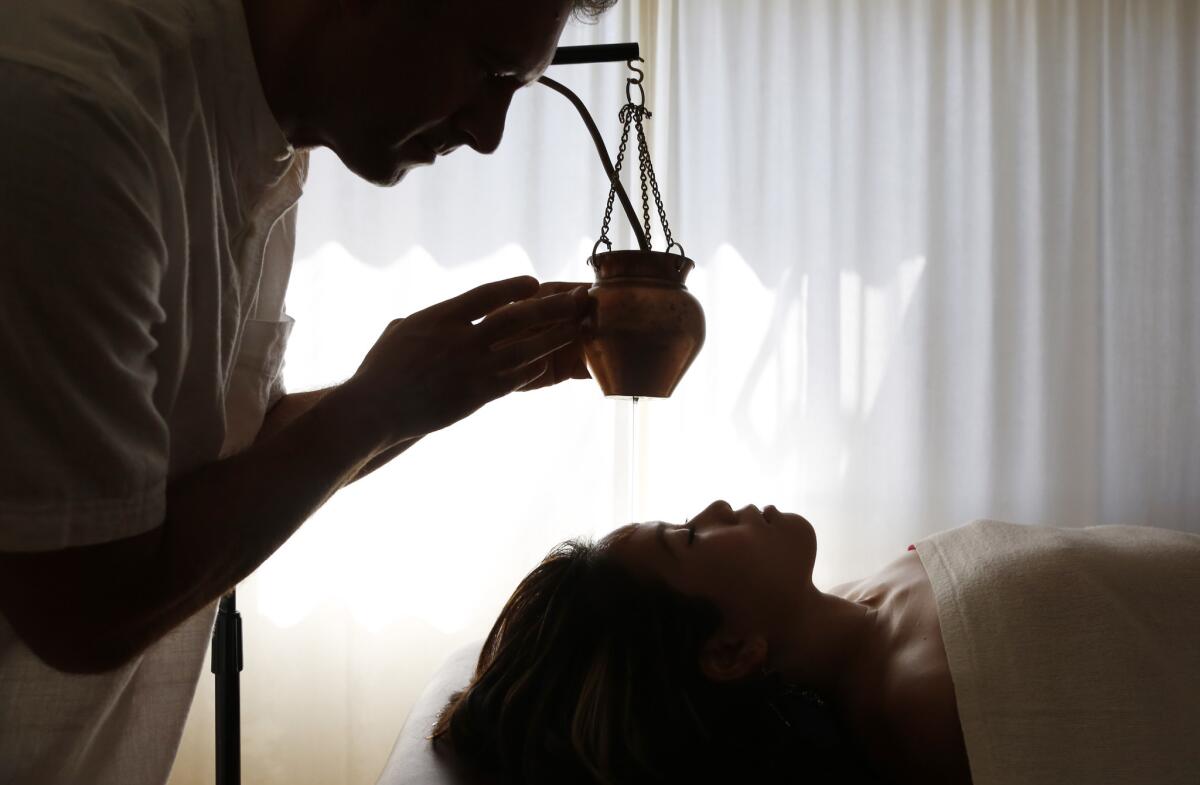Ayurvedic medicine: History, basics, treatments and caveats

- Share via
If you’re of a certain age in the U.S., Deepak Chopra may have been your introduction to Ayurvedic medicine. The author of “Perfect Health” and Ayurvedic practitioner to the stars was ubiquitous on talk shows and newsstands in the 1990s.
But the traditional Indian medicine has come a long way even since then. With federally funded research into the efficacy of traditional remedies, a growing number of Ayurvedic schools and spas, and stricter regulations for certification on the horizon, it may be time to consider what Ayurveda can do for your health.
(The fact that massage and yoga are among Ayurveda-approved treatment options probably doesn’t hurt either.)
Intrigued? Here’s a primer, based on educators, practitioners and followers of Ayurveda.
Where it all began
Ayurveda originated thousands of years ago in India. Texts describing it were written as appendices to the Vedas, the ancient Hindu scriptures. But that’s more of a cultural connection than a dogmatic one. Religion doesn’t play a key role in the practice of Ayurveda; the concept of balance or harmony is more important.
Good health is an indication that the body and environment are in harmony, while illness is a sign of imbalance, on a spiritual, mental or physical level.
Role of the doshas
Ayurvedic practitioners believe that each person is born with a unique mixture of the three doshas: Vata, Pitta and Kapha. Each dosha itself represents a different combination of the five elements: space, air, fire, water and earth.
Figuring out a person’s ideal doshic balance is the first step in diagnosing and treating disease. Usually people have one or two predominant doshas. But if the principal dosha becomes too strong, or a weaker dosha flares up, this imbalance can cause illness.
Doshas and your health
The Vata dosha represents space and air. It is related to movement and change in the body, such as circulation and respiration. It results in lively, energetic natures, though too much Vata can mean anxiety, dryness or flightiness.
The Pitta dosha is associated with fire and water. This dosha controls digestion and the metabolism. Pitta characters are strong and intelligent, but they can also become hot tempered and suffer from ailments such as heartburn and ulcers.
Kapha represents earth and water. This dosha distributes fluids in the body and is responsible for the immune system. It represents stability, which can manifest as stubbornness if the doshas become imbalanced.
Scope of care
As a holistic care system, Ayurveda encompasses preventive and clinical medicine as well as lifestyle change.
According to Marc Halpern, founder of the California College of Ayurveda, the traditional Indian medicine can be used to treat the full spectrum of disease, from arthritis, asthma or sports injuries to conditions such as heart disease, multiple sclerosis and cancer.
“Ayurveda is unique because it is a system of medicine that address both the cause and effect,” he said.
But medical institutions such as the American Cancer Society, which includes information about Ayurveda on its website, emphasize that Ayurveda is a complementary therapy, not a replacement for more conventional treatment.
Treatments
Ayurvedic remedies include herbal medicines, meditation and yoga, massage and aromatic oils. The goal of all treatment options is to restore balance within a person.
Change in diet is usually the first form of treatment. In Ayurveda, a person’s diet should be tailored to his or her doshas. Eating the wrong kind of foods can throw a person’s Vata, Pitta and Kapha out of whack. This has less to do with carbs than with the elemental nature of certain foods, as Penelope Jennings, an administrative worker in UCLA’s biochemistry department, learned when she started using Ayurvedic medicine recently.
“I loved to eat fish and avocado, and considered them healthy staples in my diet,” Jennings said.
But she also suffered from chronic sinus infections. An Ayurvedic practitioner diagnosed a Kapha imbalance — too much fluid in the body — and suggested eliminating fish, avocado and raw vegetables from her diet. Those foods are associated with exacerbating the Kapha dosha.
As a result, Jennings said, “my sinuses were completely clear within a month,” something that two surgeries had been unable to accomplish.
What to know before trying
Unlike some other alternative medicine programs in the U.S., Ayurveda schools aren’t subject to national regulations, so the quality of education and training can vary widely. Standards are enforced by the National Council on Ayurvedic Education and the National Ayurvedic Medical Assn. But oversight is limited to the schools that voluntarily become members. In 2016, the two organizations plan to implement a national board certification exam.
Ayurvedic herbal medicines, many of which don’t have to be reviewed by the Food and Drug Administration before going on the market, also have been found to contain toxins. In 2008, the National Center for Complementary and Alternative Medicine examined 193 Ayurvedic products and found that 21% contained levels of lead, mercury and arsenic that exceeded standards for acceptable daily intake.
But the biggest challenge for newcomers to Ayurveda is getting over the Western mind-set that good health comes from a quick-fix pill or an acupuncture needle, said Daniel Krasofski, a local practitioner with more than 20 years of experience.
“Ayurveda is not an instantaneous medicine,” said Krasofski. “It’s a lifestyle.”





